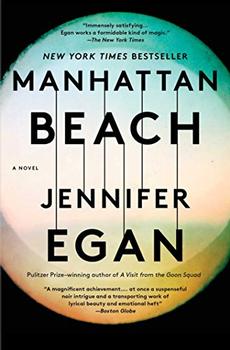Summary | Excerpt | Reading Guide | Reviews | Beyond the Book | Read-Alikes | Genres & Themes | Author Bio

This article relates to Manhattan Beach
In Manhattan Beach, Jennifer Egan has produced a closely researched exploration of life in New York City during World War II and describes a range of ways in which New York women became involved in the war effort.
Brooklyn Navy Yard
During the 1930s a small number of women worked at the Brooklyn Navy Yard, almost exclusively in administrative positions. But with America's entry into World War II, that changed radically. From August 1942 onward, women began working in trade jobs – shopfitting, driving, welding and operating elevators. The Yard, which had been in existence since 1806, expanded to 282 acres, cover approximately 0.4 square miles of land. Within its boundaries there were five miles of streets lined with warehouses, foundries and machine shops. USS Iowa and USS Missouri were built there. By January 1945, the Navy Yard had more than 4,000 women employees working in production and a further 2,300 in clerical positions. With a total workforce of roughly 70,000, the percentage of women workers was small but still significant. The women were recruited aggressively but most were quickly laid off when the war ended and male veterans returned, in need of work.
The New York Historical Society has a collection of photographs of women working in a range of roles in the Navy Yard during World War II. Some are available to view here.
Bundles for Britain
 Dexter Styles, in Manhattan Beach, dismisses Bundles for Britain as "society dressed up as war work," but this initiative, started by New York socialite Natalie Wales Latham, became a significant enterprise. Described as one of the twentieth century's most inspired relief efforts, it began with Latham forming a knitting circle which met at a storefront in the city and made socks, gloves, sweaters and scarves to send to Britain. Bundles quickly expanded. Anyone with free time or spare clothing could contribute and the organization focused on collecting or making supplies and shipping them to Britain, rather than simply raising money. Bundles for Britain grew to include 1.5 million volunteers in branches across the US sending not only knitted items but also ambulance supplies, children's cots and even x-ray machines.
Dexter Styles, in Manhattan Beach, dismisses Bundles for Britain as "society dressed up as war work," but this initiative, started by New York socialite Natalie Wales Latham, became a significant enterprise. Described as one of the twentieth century's most inspired relief efforts, it began with Latham forming a knitting circle which met at a storefront in the city and made socks, gloves, sweaters and scarves to send to Britain. Bundles quickly expanded. Anyone with free time or spare clothing could contribute and the organization focused on collecting or making supplies and shipping them to Britain, rather than simply raising money. Bundles for Britain grew to include 1.5 million volunteers in branches across the US sending not only knitted items but also ambulance supplies, children's cots and even x-ray machines.
In addition to these developments originating in New York, thousands of women in the city enlisted as WACS, WAVES & WASPs:
In May 1942, the U.S. Congress passed a bill creating the Women's Army Auxiliary Corps (WAAC). By 1943 this had become the Women's Army Corps (WAC) and granted military status to women in the army. WACs could be switchboard operators, mechanics, bakers, clerks, drivers, typists, and more. Approximately 150,000 women trained in the Women's Army Corps in WWII. The first enlisted woman to the Manhattan District WAC detachment was Myrtle L. Hayes. She served as a First Sergeant for two years.
WAVES was the women's branch of the United States Naval Reserve, an acronym for Women Accepted for Volunteer Emergency Service. The Navy recruited women to staff home facilities so that more men could be released into active service overseas. WAVES operated in 900 stations across the United States. At its height, there were over 85,000 WAVES. Between 1943 and 1945, the Bronx campus of Hunter College (now Lehman College) accommodated more than 80,000 WAVES for boot-camp training.
The WASPs were a much smaller branch of women in the military, but noteworthy as the first women in American history to fly military aircraft. Although 25,000 women applied to be WASPs, only 1830 were selected for training and only just over 1000 became WASPS. Katherine Kornblum was one of a group of New York "fly girls" honored at Capitol Hill in 2010. While not allowed to fly combat missions, they racked up over 60 million miles transporting planes to where they were needed.
Picture of WAAC recruitment poster from Office of Emergency Management
Filed under People, Eras & Events
![]() This "beyond the book article" relates to Manhattan Beach. It originally ran in October 2017 and has been updated for the
June 2018 paperback edition.
Go to magazine.
This "beyond the book article" relates to Manhattan Beach. It originally ran in October 2017 and has been updated for the
June 2018 paperback edition.
Go to magazine.
Your guide toexceptional books
BookBrowse seeks out and recommends the best in contemporary fiction and nonfiction—books that not only engage and entertain but also deepen our understanding of ourselves and the world around us.